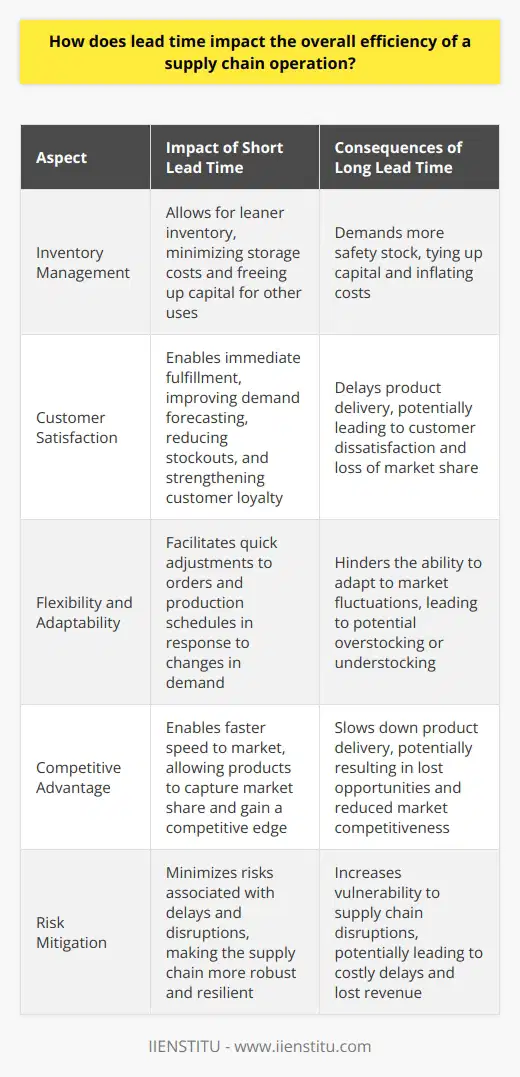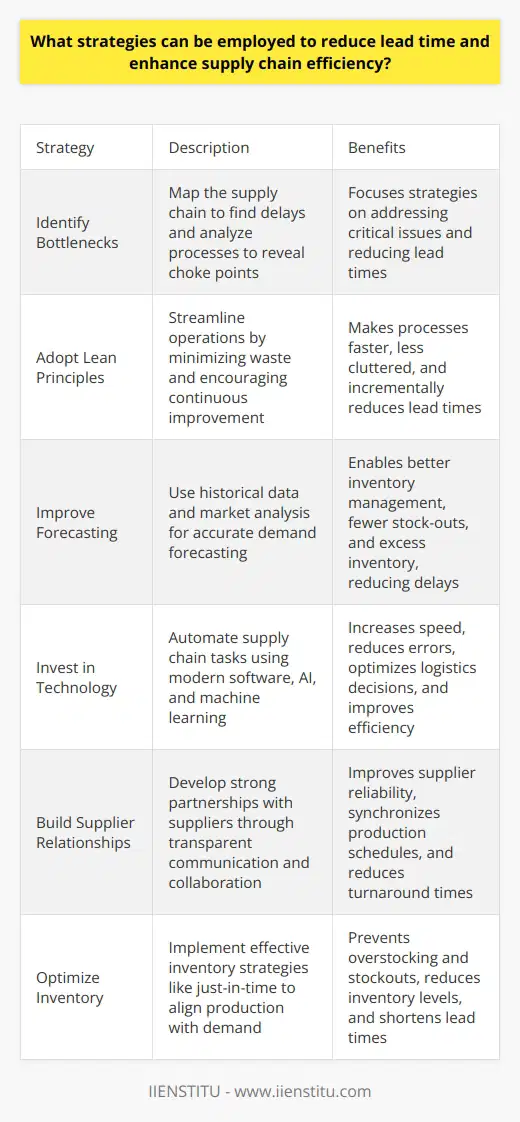
In today’s fast-paced business environment, proficiency in managing logistics and supply chain processes is a clear determinant of an organization's success. At the core of these processes lies an essential concept known as Lead Time, which denotes the total time taken from the initiation of a process until its completion.
Explore our online logistics training courses with certificates, offering a deep dive into the concept of Lead Time in supply chain management – a key to driving business efficiency in today's dynamic market. This comprehensive article discusses the types, impacts, and optimization strategies of Lead Time, equipping professionals with the skills to navigate and excel in modern business logistics.
A nuanced understanding of Lead Time is fundamental in orchestrating effective business operations and maintaining competitive advantage. This article delves into the intricacies of Lead Time, examining its diverse types, impacts on various business aspects, and the strategies to optimize it for efficiency enhancement.
Understanding Lead Time
Detailed Explanation of Lead Time
Lead Time encapsulates the period required to complete a specific process after the initial demand is placed. In manufacturing and supply chain contexts, this encompasses the time necessary for the production of goods, the handling of raw materials, and the delivery to the end customer.
The concept may seem straight-forward, yet it involves an interplay of various stages, each contributing to the total length of the Lead Time. Unpacking its complexity is crucial in identifying bottlenecks and potential areas for efficiency improvement.
Various Elements Involved in Lead Time
Lead Time is influenced by numerous elements, ranging from supplier responsiveness and production speed to transportation and distribution capabilities.
Factors such as queue times, processing times, movement times, and waiting times between successive steps are integral components that cumulatively define the entirety of Lead Time. A granular analysis of these elements enables managers to pinpoint inefficiencies at each stage, simplifying the overarching complexity into manageable focal points for improvement.
Understanding Logistics: A Comprehensive Guide to the Meaning, Components, and Role in Business
Scrutinizing the Key Aspects of Successful Inbound Logistics
Different Types of Lead Time in Business
Production Lead Time
Definition and Explanation
Production Lead Time is the timespan from when a production order is placed until the finished goods are produced. It's a critical component in manufacturing, reflecting the efficiency of the production line. The duration of this lead time influences inventory levels, cost-control measures, and the ability to meet customer demand.
Importance and Application with Example
Understanding Production Lead Time is also essential in scheduling and work-in-progress optimization. For example, a furniture manufacturer might take two weeks to transform lumber into a finished chair. By reducing inefficiencies within the production process, the furniture maker could decrease Lead Time, thereby expediting delivery to customers and improving turnover rates.
Shipping Lead Time
Definition and Explanation
Shipping Lead Time refers to the time it takes for a product to be transported from the supplier to the customer. It encompasses the entire logistics process, including order fulfillment, picking, packing, loading, transit, and delivery. The reliability and efficiency of a company's shipping operations are pivotal in maintaining customer satisfaction and smooth turnover.
Importance and Application with Example
For illustration, an online retailer's shipping Lead Time directly affects customer experience. If a customer is promised two-day delivery, the company must have a well-coordinated shipping strategy to honor that commitment. Any delays can result in dissatisfied customers and potentially lost sales, showcasing the critical nature of optimized shipping logistics.
Procurement Lead Time
Definition and Explanation
Procurement Lead Time is the interval between placing an order with a supplier and receiving the order. It includes time for order processing, production by the supplier, and transportation to the buyer. This can often be the longest portion of the Lead Time, particularly for specialized or imported goods.
Importance and Application with Example
For instance, a smartphone manufacturer relying on specific components from an overseas supplier will have to account for the procurement Lead Time in its product release timelines. Any delays in receiving these components can have a domino effect on the overall product availability in the market.
The Impact of Lead Time on Business Operations
Relationship between Lead Time and Customer Satisfaction
Customer satisfaction is intricately linked to Lead Time because it directly influences the perceptions of a brand’s reliability and efficiency. Shorter lead times can lead to faster delivery, which tends to boost customer satisfaction. Accurate forecasts and timely communication can further enhance trust and foster long-term customer relationships.
The Effect of Lead Time on Inventory Management
Proper Lead Time management is paramount in determining inventory levels. Excessively long lead times necessitate higher inventory levels to buffer against potential delays, increasing holding costs and risks of obsolescence. Conversely, minimizing lead times can lead to leaner inventory, reducing costs and the capital tied up in stock.
Role of Accurate Lead Time Prediction in Improving Efficiency
Incorporating precise Lead Time predictions into planning and scheduling enhances the entire supply chain's responsiveness and agility. Companies that can accurately estimate lead times are better positioned to respond to market fluctuations and customer demands, thereby improving overall operational efficiency and competitive edge.
Strategies to Reduce Lead Time
Lean Manufacturing and its Impact on Lead Time
Lean manufacturing is an established methodology aimed at waste reduction and value maximization. Adoption of lean practices can significantly streamline production processes, thus curtailing the production Lead Time. Lean tools such as value stream mapping help in understanding and optimizing the flow of materials and information, enabling a more synchronised and efficient production schedule.
Benefits of Automation in Lead Time Reduction
The integration of automation within the supply chain can drastically shrink Lead Time by accelerating tasks that were previously manual, such as order processing, inventory tracking, and even certain elements of production. Automation minimizes human error and enhances speed, which can lead to substantial Lead Time reductions.
The Role of Supplier Relationships in Reducing Lead Time
Strong supplier relationships can be leveraged to minimize procurement Lead Time, as trusted suppliers are more likely to prioritize a company’s needs and collaborate to find faster delivery solutions. Firms investing time and resources into cultivating such partnerships can gain quicker turnaround times and more responsive supply chain dynamics.
Real-life Examples of Lead Time Management
Case Study: Lead Time Reduction in the Automotive Industry
In the automotive industry, manufacturers such as Toyota have exemplified the effective management of Lead Time. Through adopting the Just-In-Time (JIT) production philosophy, which is a facet of lean manufacturing, Toyota has substantially lowered its production Lead Time, leading to reduced costs and better alignment of supply with actual customer demand.
Case Study: How E-commerce Companies Manage Lead Time
Major e-commerce companies, like Amazon, have pushed the envelope in managing and reducing shipping Lead Time through advanced logistics networks and distribution strategies, such as fulfillment by Amazon (FBA). By positioning inventory close to customer populations and optimizing delivery routes, these companies can offer same-day or next-day delivery services, setting a high industry standard for minimal shipping lead times.
To conclude, Lead Time is an essential measure that directly correlates with the efficiency and success of business operations. Its impact on inventory management, customer satisfaction, and overall efficiency cannot be understated.
Business leaders are encouraged to apply the insights and strategies discussed in this article, such as embracing lean practices, leveraging technology, and nurturing supplier relationships, to effectively manage and mitigate Lead Time. In an economic climate where consumers value speed and reliability, mastery of Lead Time can be a decisive factor for achieving organizational excellence and enduring competitive advantage.
Frequently Asked Questions
How does lead time impact the overall efficiency of a supply chain operation?
The Role of Lead Time in Supply Chain Efficiency
Lead time holds a critical place in supply chain operations. It measures the time span from order placement to delivery. A shorter lead time can amplify the responsiveness of a supply chain. Efficiency emerges as a core objective.
Understanding Lead Time
Central to supply chain mastery, lead time influences inventory management. It reflects the agility with which a supply chain reacts. Operations hinge on this factor.
Impact on Inventory Management
Lead time affects inventory strategies. A long lead time demands more safety stock. This stock acts as a buffer against demand fluctuations. It ties up capital and inflates costs.
Reduced lead time, conversely, allows for leaner inventory. Stores minimize, releasing funds for other uses. The business enjoys lower holding costs. Efficiency naturally improves.
Customer Satisfaction
Immediate fulfillment drives customer satisfaction. Short lead times meet this need. Clients get goods faster. Supply chains that achieve this thrive.
- Demand forecasting improves.
- Stockouts become less frequent.
- Order cycles reduce.
Customer loyalty strengthens. A short lead time directly boosts this loyalty.
Flexibility and Adaptability
Changes in demand present challenges. A short lead time confers an adaptive edge. Suppliers can adjust orders quickly. Production schedules remain fluid.
Competitive Advantage
Speed to market matters. Products delivered quickly capture market share. A short lead time propels products forward.
Risk Mitigation
Supply chains face inherent risks. Delays and disruptions prove costly. A reduced lead time minimizes these risks. The chain becomes more robust.
Conclusion
Lead time touches every aspect of supply chain operations. Efficiency gains from its reduction bear significant weight. Supply chain strategies must prioritize lead time optimization. In doing so, they secure a competitive and efficient future.

What strategies can be employed to reduce lead time and enhance supply chain efficiency?
Understanding Lead Time and its Impact
Lead time plays a crucial role in defining a supply chain's agility. It measures the time from initiating a process until its completion. This interval affects inventory levels, customer satisfaction, and overall competitiveness. Business leaders strive to reduce lead times. They seek to enhance their supply chain efficiencies.
Strategies for Reducing Lead Time
Identify bottlenecks.
The first step is mapping the supply chain. One must find where delays typically occur. Analysing processes reveals these choke points. Strategies then focus on addressing these critical issues.
Adopt lean principles.
Lean manufacturing aims to minimize waste. It streamlines operations. Processes become faster and less cluttered with unnecessary steps. This philosophy encourages continuous improvement. It thus incrementally reduces lead times.
Improve forecasting.
Accurate demand forecasting is vital. It allows for better inventory management. Forecasting relies on historical data and market analysis. A more precise forecast leads to fewer stock-outs or excess inventory. Both of these can cause delays.
Invest in technology.
Modern software can automate many supply chain tasks. Automation increases speed and reduces error. Technologies like AI and machine learning optimize logistics decisions. This investment spurs significant gains in efficiency.
Build supplier relationships.
Developing strong partnerships with suppliers can reduce hiccups. Transparent communication helps to synchronize production schedules. Collaboration often leads to improved supplier reliability and quicker turnaround times.
Optimize inventory.
An effective inventory strategy prevents overstocking and stockouts. Just-in-time inventory aims to align production closely with demand. Reduced inventory levels often translate to shorter lead times.
Streamline supplier base.
Working with fewer, more reliable suppliers can reduce complexity. This strategy often improves coordination and speeds up processes.
Implement cross-docking.
Cross-docking minimizes storage time. Products move directly from receiving to shipping docks. This method cuts warehouse storage time dramatically.
Employ strategic sourcing.
Strategic sourcing finds the most efficient suppliers and materials. It considers cost, quality, and speed. The approach can optimize procurement activities.
Measure performance.
Metrics are essential for continuous improvement. Key performance indicators track lead time reduction efforts. They help identify what works and what does not.
Enhancing Supply Chain Efficiency
Embrace flexibility.
A flexible supply chain adapts to changes quickly. It can adjust to new information or shifting market demands. This adaptability is critical for reducing lead times.
Consolidate shipments.
Combining shipments can improve transportation efficiency. It reduces the time products spend in transit.
Improve quality control.
Better quality control reduces the need for rework or returns. Higher quality products flow through the supply chain more smoothly. Fewer disruptions mean shorter lead times.
Train employees.
Skilled workers understand how to perform their tasks efficiently. They can identify inefficiencies and suggest improvements. Proper training underpins every strategy aiming to cut lead times.
Regularly review processes.
Supply chains evolve. What works today may not work tomorrow. Regular reviews allow for adjustments in strategy. They keep supply chains aligned with best practices.
Conclusion
Supply chains must evolve to stay competitive. Strategies to reduce lead times are multifaceted. They include process analysis, lean principles, and technological investment. They favor strong supplier relationships and efficient inventory management. These practices make supply chains more responsive and efficient. Continuous improvement is crucial. The ultimate goal is to maintain an agile, customer-focused operation.

How does improved lead time translate into competitive advantage in a supply chain management context?
Understanding Lead Time in Supply Chain Management
Lead time acts as a crucial factor in supply chain efficiency. It refers to the period from the initiation of a process to its completion. In manufacturing, it spans from the order placement to the final product delivery. Shorter lead times can create a significant competitive advantage in several ways.
Streamlined Operations Enhance Responsiveness
Operations thrive on efficiency. Shorter lead times signify a more responsive supply chain. Companies can adjust and react swiftly to market changes. This agility aids in meeting customer demands faster. Quicker responses often lead to higher customer satisfaction. Satisfied customers are likely to remain loyal.
Reduced Inventory Costs Free Capital
Holding stock is expensive. It ties up capital. Short lead times reduce the necessity for large inventories. This efficiency frees capital for other investments. Consequently, businesses can allocate funds towards innovation or expansion. These strategic investments further solidify a company's market position.
Improved Quality Control Attracts Customers
Quality control is integral to customer trust. With short lead times, companies can oversee production more closely. They can identify issues quickly. Rapid problem resolution maintains product quality. High-quality products attract and retain discerning customers. Consequently, businesses with stringent quality controls gain a market edge.
Agile Fulfillment Wins Market Share
Customers crave speed. Expedited order fulfillment can outpace competitors. Companies with swift supply chains capture market share more easily. They meet the instant gratification trend prevalent among modern consumers. Fast fulfillment becomes a brand differentiator. It can turn first-time buyers into repeat customers.
Dynamic Pricing Promotes Profit Maximization
Prices often fluctuate in response to demand. Improved lead times offer flexibility in pricing strategies. Companies can manage costs better and promote profit maximization. Dynamic pricing allows businesses to remain competitive during demand peaks. This strategy can draw cost-sensitive customers away from competitors.
Better Supplier Relationships Increase Reliability
Suppliers are key supply chain partners. Short lead times foster stronger supplier relationships. Reliable suppliers are more likely to prioritize responsive clients. They offer quicker turnaround times underpinning a competitive supply chain. Strong relationships also offer better terms and cost savings.
Enhanced Forecasting Reduces Risks
The ability to forecast accurately is vital. It enables businesses to plan better. Improved lead times grant a clearer view of the supply chain. Companies can predict and mitigate potential disruptions. Risk reduction is a significant competitive advantage. It ensures consistent product availability against competitors who might face stockouts.
Conclusion
Effectively managing lead times can transform a supply chain. It offers a blend of cost efficiency, market responsiveness, and risk mitigation. These factors combined create a formidable competitive advantage. Integrating such advantages is key to dominating the marketplace. Businesses that strive for shorter lead times secure their position as industry leaders.



